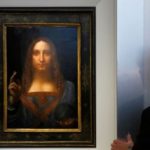It took more than a decade to prepare and was almost thwarted by a diplomatic row. Now, one of the world’s most expensive art exhibitions – to commemorate the 500th anniversary of Leonardo da Vinci’s death – is finally opening to the public.
The Louvre museum in Paris, home to Da Vinci’s Mona Lisa, opens its doors on Thursday to a display of more than 160 Renaissance-era paintings and drawings, some of which are on loan from Queen Elizabeth II and Bill and Melinda Gates.
The exhibition, which is expected to attract more than half a million visitors over the next four months, aims to provide a deeper understanding of the artist’s working methods using his notebooks, infrared imaging technology and virtual reality.
Shining infrared light on some of his most famous artworks has revealed a number of secrets, with multiple layers of drawings discovered beneath the artist’s finished pieces.
It is not the first time this method has been used. In August, experts found designs for the angel and infant Christ beneath the surface of Leonardo’s The Virgin of the Rocks, using macro X-ray fluorescence maps and infrared and hyperspectral imaging.
Leonardo da Vinci was an engineer, designer, scientist and artist who was fascinated with the human form and the behaviours of animals and plants.
From the growth of trees to the motion of birds – he was obsessed with flight and designed a flying machine based on the wings of a bat – Leonardo studied the complexities and documented them with drawings. Some of those drawings are on show here.
He also designed weapons, tools and utensils, and his notebooks also include interpretations of architectural building techniques.
Among the most celebrated of works on loan to the Louvre is Leonardo’s Vitruvian Man, a pen-and-ink drawing of a perfectly proportioned human form inside a square and circle.
The piece, which will form part of the exhibition for eight weeks, was transported to Paris just last week despite attempts to ban it from leaving Italy.
Standing alongside the delicate artwork, exhibition co-curator Vincent Delieuvin said the drawing showed the importance of the relationship between science and art. “In this case, it shows the beauty of the [human] body,” he said.
“We hope to show who he was as an artist, why and how Leonardo was so important. [He used a] very particular and original method of work based on science.”
The Mona Lisa, perhaps one of the artist’s best-known paintings, does not feature in this exhibition in its physical form – it is kept elsewhere at the Louvre in a protected glass case – but visitors can see the painting Beyond the Glass.
The virtual reality experience, the first of its kind at the Louvre, incorporates scientific research to reveal details within the painting otherwise invisible to the naked eye, say the developers of the project, Vive Arts.



